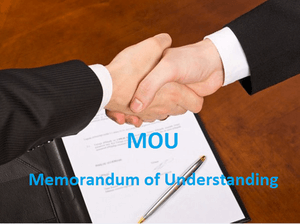MOU Full Form | What is Memorandum of Understanding
What is the Full Form of MOU?
MOU: Memorandum of Understanding
MOU stands for Memorandum of Understanding. It is a written and non-disclosure agreement that signifies a congruity among two or more parties. The MOU is voluntary and not a valid or legal commitment. However, it binds the bilateral and multilateral in the rules and regulations proclaimed in it. It acts as a piece of evidence among bilateral and multilateral of signing an agreement with each other.
Memorandum of Understanding
The memorandum of understanding is generally preferred by the parties when they don't want to be enforced by any obligations by law. Although any legal commitments are quoted in the memorandum of understanding, then the parties are obligated to follow it.
Inclusion in an MOU
The MOU between the parties demonstrates their readiness to work and start a project or work together. A memorandum of understanding includes the focus of attention on the agreement and the output of the parties. To make MOU agreeably no need; the parties have to sign on the basic terms and conditions. A memorandum of understanding indicates the beginning of the discussion regarding the process. Many private organizations and companies adopt the MOU and government agencies to start any project or work.
Major Content and format of MOU
When parties sign a memorandum of understanding between them, they should be clear and transparent to each other so that they are aware of what to anticipate from the partnership and the way they move ahead to attain their desired target. The party has a right to frame its own rules and consider the interest of the companion party as well.
Following are the content that is generally included in the memorandum of understanding:
- The intent- The intent is to explain the goals that are intended to achieve from the partnership. The intend should be effortless with no complications to clarify the purpose.
- Details of the parties- Particular parties that will be a part of a memorandum of understanding should mention their names and details required to fill. For example, the parties can be organizations, countries, institutions, or trade companies.
- Term of MOU - This section involves the time for how long the MOU has been framed and its validity term. The MOU is not eternal and can be denied anytime after its validity is over.
- Responsibilities of parties involved - This section includes the responsibilities that are to be fulfilled by the parties. It states the combined responsibilities among the parties who signed the MOU. The details should be mentioned clearly to give a clear view of the standards adopted by the parties to achieve the aim quoted in the memorandum of understanding. The section also contains all the details about the parties' resources and their contribution towards their project or work.
- Disclaimer - The parties must keep themselves apart from some procedure, authority, and facts, which should be laid down in the disclaimers. If there is any controversy in the settlements, then it should be mentioned in this section.
- Financial Section - The financial section involves the financial settlements in detail in the MOU. It contains the details about the investment that needs to be made, the revenue that is to be shared, and the interest that has to be paid.
- Risks sharing -Some sort of risk can be borne during the partnership, and the party should adopt it. The risk that arises can be under the control of the party or can be involuntary sometimes. Unaware of the risks behavior, all forms of the risks should be appropriately covered in the MOU, and also, it should quote the risk that the parties have to share combined during the partnership.
- Signatures - The signature of each party or representative are compulsory as it implies that they are agreed to all the terms and conditions covered in the memorandum of understanding.
Advantages of MOU
MOU has its advantages, which are given following:
- The MOU layout all the Roles and responsibilities of the parties involved in the project or work.
- The MOU is a way better option than the verbal commitments.
- The MOU will provide you a good reference if any dispute occurs between the project partners.
- The MOU showcases the intention of the parties working towards a similar goal.
- The MOU is more straightforward and stress-free than the legal contract.
- While the two countries are signing the MOUs, the restriction made under any international law can be neglected.